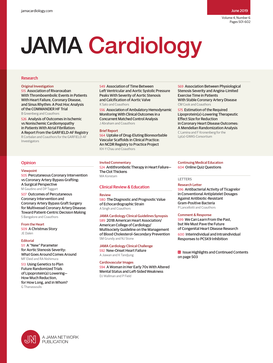不良妊娠结局和房颤的长期风险。
IF 14.1
1区 医学
Q1 CARDIAC & CARDIOVASCULAR SYSTEMS
引用次数: 0
摘要
有不良妊娠结局的妇女有较高的后续心血管风险,但其房颤(AF)的长期风险和潜在的因果关系尚不清楚。需要更好地了解这些风险,以便在生命早期识别高风险妇女,并指导干预措施预防房颤及其并发症。目的在一项基于人群的大队列研究中,确定AF与6种主要不良妊娠结局相关的长期风险,并利用同胞分析评估家族性混杂因素。设计、环境和参与者本国家队列研究包括1973年至2015年间瑞典所有单胎分娩的妇女。分析在2025年5月23日至8月18日之间进行。不良妊娠结局(早产、小胎龄、大胎龄、先兆子痫、其他高血压疾病和妊娠糖尿病),从全国出生记录中确定。主要结局和措施主要结局是从2018年全国住院和门诊诊断中确定的房颤。采用Cox回归计算AF与特定不良妊娠结局相关的风险比(hr),并对其他母体因素进行调整。同胞分析评估了由共同家族(遗传和/或环境)因素引起的潜在混淆。结果在随访5400万人年的2 201 047名女性中,51 173名(2.3%)被诊断为AF(诊断时中位[IQR]年龄为63[56-69]岁)。除胎龄小外,所有不良妊娠结局均与房颤的长期风险增加相关。分娩后10年内,房颤的调整HR仅在其他高血压疾病(HR, 1.69; 95% CI, 1.32-2.15)、早产(HR, 1.46; 95% CI, 1.26-1.70)或胎龄大(HR, 1.16; 95% CI, 1.01-1.32)的妇女中显著升高。然而,在分娩后30至46年,其他高血压疾病(HR, 1.44; 95% CI, 1.24-1.66)、先兆子痫(HR, 1.38; 95% CI, 1.33-1.50)、妊娠期糖尿病(HR, 1.19; 95% CI, 1.03-1.37)、胎龄较大(HR, 1.17; 95% CI, 1.14-1.21)或早产(HR, 1.11; 95% CI, 1.07-1.16)的妇女的调整HR增加。这些发现在很大程度上无法用共同的家族因素来解释。有多种不良妊娠结局的妇女的风险进一步增加。结论:在这个庞大的国家队列中,除了胎龄小外,所有不良妊娠结局都与46年后房颤风险增加相关。有不良妊娠结局的妇女需要采取早期预防措施和长期临床随访,及时发现和治疗与房颤相关的心血管疾病。本文章由计算机程序翻译,如有差异,请以英文原文为准。
Adverse Pregnancy Outcomes and Long-Term Risk of Atrial Fibrillation.
Importance
Women with adverse pregnancy outcomes have higher subsequent cardiovascular risks, but their long-term risk of atrial fibrillation (AF) and potential causality are unclear. A better understanding of such risks is needed to identify women with high risk early in life and guide interventions to prevent AF and its complications.
Objective
To determine long-term risks of AF associated with 6 major adverse pregnancy outcomes in a large population-based cohort and assess for familial confounding using cosibling analyses.
Design, Setting, and Participants
This national cohort study included all women with a singleton delivery in Sweden between 1973 and 2015. Analyses were conducted between May 23 and August 18, 2025.
Exposures
Adverse pregnancy outcomes (preterm delivery, small for gestational age, large for gestational age, preeclampsia, other hypertensive disorders, and gestational diabetes), identified from nationwide birth records.
Main Outcome and Measures
The primary outcome was AF identified from nationwide inpatient and outpatient diagnoses through 2018. Cox regression was used to compute hazard ratios (HRs) for AF associated with specific adverse pregnancy outcomes, adjusting for other maternal factors. Cosibling analyses assessed for potential confounding by shared familial (genetic and/or environmental) factors.
Results
Among 2 201 047 women with 54 million person-years of follow-up, 51 173 (2.3%) were diagnosed with AF (median [IQR] age at diagnosis, 63 [56-69] years). All adverse pregnancy outcomes except small for gestational age were associated with long-term increased risks of AF. Within 10 years following delivery, adjusted HRs for AF were significantly elevated only among women with other hypertensive disorders (HR, 1.69; 95% CI, 1.32-2.15), preterm delivery (HR, 1.46; 95% CI, 1.26-1.70), or large for gestational age (HR, 1.16; 95% CI, 1.01-1.32). However, at 30 to 46 years after delivery, adjusted HRs were increased among women with other hypertensive disorders (HR, 1.44; 95% CI, 1.24-1.66), preeclampsia (HR, 1.38; 95% CI, 1.33-1.50), gestational diabetes (HR, 1.19; 95% CI, 1.03-1.37), large for gestational age (HR, 1.17; 95% CI, 1.14-1.21), or preterm delivery (HR, 1.11; 95% CI, 1.07-1.16). These findings were largely unexplained by shared familial factors. Women with multiple adverse pregnancy outcomes had further increases in risk.
Conclusions
In this large national cohort, all adverse pregnancy outcomes except small for gestational age were associated with increased risk for AF up to 46 years later. Women with adverse pregnancy outcomes need early preventive actions and long-term clinical follow-up for timely detection and treatment of cardiovascular disorders related to the development of AF.
求助全文
通过发布文献求助,成功后即可免费获取论文全文。
去求助
来源期刊

JAMA cardiology
Medicine-Cardiology and Cardiovascular Medicine
CiteScore
45.80
自引率
1.70%
发文量
264
期刊介绍:
JAMA Cardiology, an international peer-reviewed journal, serves as the premier publication for clinical investigators, clinicians, and trainees in cardiovascular medicine worldwide. As a member of the JAMA Network, it aligns with a consortium of peer-reviewed general medical and specialty publications.
Published online weekly, every Wednesday, and in 12 print/online issues annually, JAMA Cardiology attracts over 4.3 million annual article views and downloads. Research articles become freely accessible online 12 months post-publication without any author fees. Moreover, the online version is readily accessible to institutions in developing countries through the World Health Organization's HINARI program.
Positioned at the intersection of clinical investigation, actionable clinical science, and clinical practice, JAMA Cardiology prioritizes traditional and evolving cardiovascular medicine, alongside evidence-based health policy. It places particular emphasis on health equity, especially when grounded in original science, as a top editorial priority.
 求助内容:
求助内容: 应助结果提醒方式:
应助结果提醒方式:


